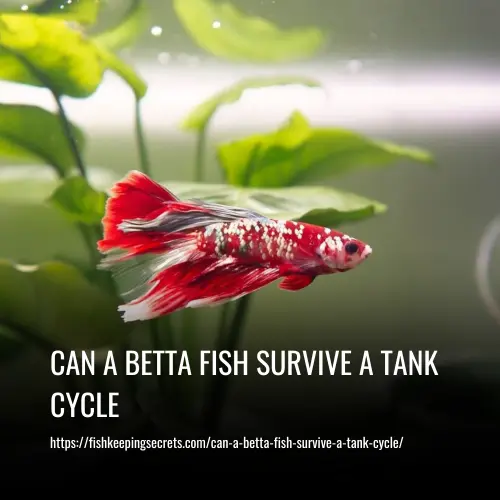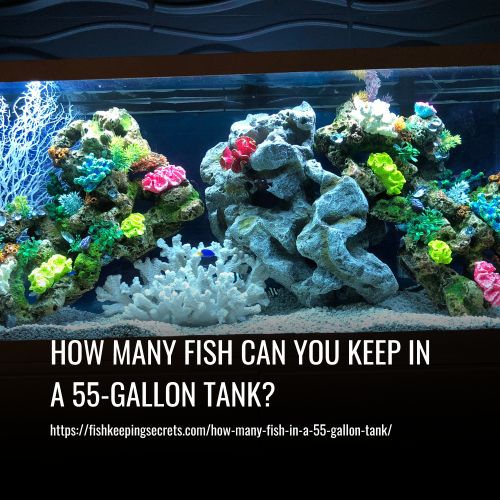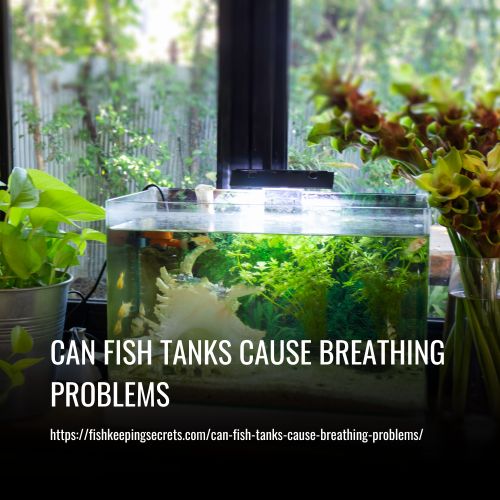Can A Betta Fish Survive A Tank Cycle
This post contains affiliate links. As an Amazon Associate, we earn from qualifying purchases.
Yes, a betta fish can survive a tank cycle. It is not ideal for them, but they are resilient enough to endure the process.
Betta fish are a popular choice of pet fish due to their bright colours and easy-to-maintain nature. However, to keep them healthy and happy, you need to provide them with a suitable habitat. One important aspect of this is tank cycling, which helps establish a healthy environment for your fish by building up beneficial bacteria in the tank.
This process can last for several weeks, during which time your fish may experience stress and discomfort. But with proper care and attention, your betta can survive the cycle and thrive in their new home.

Understanding Betta Fish And Their Natural Habitat
Overview Of Betta Fish’S Natural Environment
Betta fish are native to southeast asia and can be found in shallow, slow-moving waters such as rice paddies, ponds, streams, and swamps. Betta fish require access to the surface of the water to breathe air directly through their gills.
They are often found in areas with dense vegetation and plenty of hiding spots. Bettas typically live in warm, tropical climates with temperatures ranging from 75-82°f.
Key points:
- Betta fish are native to southeast asia.
- They are found in shallow, slow-moving waters with access to the surface for breathing.
- Bettas require warm, tropical temperatures to thrive.
Betta Fish Behavior
Betta fish are known for their colorful, flowing fins and aggressive behavior. Males are territorial and will fiercely defend their area from other males and even their reflections. In contrast, females are typically peaceful and can coexist with other females.
Betta fish are also known for their bubble nests, which they create to attract a mate. They are generally solitary creatures and prefer to swim alone.
Key points:
- Male bettas are territorial and will fight other males.
- Females are typically peaceful and can coexist with other females.
- Bettas create bubble nests to attract a mate.
Relationship Between Natural Environment And Survival Of Betta Fish
Understanding the natural environment of betta fish is crucial for their survival in a tank. Proper water conditions, including temperature, ph level, and water quality, are essential for their health. The tank should also provide plenty of hiding spots and vegetation similar to their natural habitat.
Key points:
- Proper water conditions are essential for betta fish health.
- Tanks should include hiding spots and vegetation to mimic their natural habitat.
- Understanding the natural environment of betta fish is crucial for their survival in a tank.
What Is Tank Cycling?
Have you ever wondered what tank cycling is and why it’s important for your betta fish’s health? Let’s explore the meaning and importance of tank cycling, the nitrogen cycle in aquariums, and the types of bacteria involved in the nitrogen cycle.
Meaning And Importance Of Tank Cycling
Tank cycling refers to the process of establishing a healthy bacterial colony in a new aquarium. This process is critical for the health and survival of your betta fish. When you first set up your aquarium, it does not contain the necessary bacteria to break down fish waste.
Tank cycling allows beneficial bacteria to accumulate, which will help break down harmful ammonia and nitrite compounds.
Proper tank cycling helps to establish a stable and healthy environment for your betta fish. Without it, your betta fish can easily become stressed or sick, leading to a shortened lifespan.
Nitrogen Cycle In Aquariums
The nitrogen cycle is a natural process that occurs in all aquariums. Here’s how it works:
- Your betta fish produces ammonia when they excrete waste.
- Beneficial bacteria called nitrosomonas convert the ammonia into nitrite.
- Another type of beneficial bacteria, nitrobacter, then converts the nitrite into nitrate.
- Nitrate is less harmful to your betta fish, and can be removed through regular water changes.
It’s important to note that the nitrogen cycle can take several weeks to establish in a new aquarium. However, without it, your betta fish will be living in a toxic environment that could be harmful to their health.
Types Of Bacteria Involved In Nitrogen Cycle
There are two types of beneficial bacteria involved in the nitrogen cycle- nitrosomonas and nitrobacter.
- Nitrosomonas bacteria convert toxic ammonia into nitrite
- Nitrobacter bacteria convert the nitrites into less harmful nitrates
It is essential to have these bacteria colonies present in your aquarium to maintain a healthy environment for your betta fish.
Ensuring that your aquarium is properly cycled before introducing your betta fish is crucial for their health and survival. Use a water testing kit to monitor the chemical levels in your tank, and perform regular water changes to keep your pet healthy.
With proper tank cycling and maintenance, your betta fish can thrive in their aquarium home.
Betta Fish And Tank Cycling
Betta fish, also known as siamese fighting fish, are a popular choice for novice and expert aquarists alike due to their vibrant colors and easy maintenance. However, keeping betta fish healthy and happy requires a well-cycled tank. Tank cycling is the process of establishing beneficial bacteria in the aquarium that breaks down harmful toxins like ammonia, nitrite, and nitrate.
Betta fish and tank cycling are intricately related, and understanding this relationship is crucial for keeping them in a healthy environment.
How Betta Fish Survive The Nitrogen Cycle
The nitrogen cycle is a natural process that takes place in any aquatic ecosystem, including a betta fish tank. In simpler terms, the nitrogen cycle consists of three stages: the production of ammonia from fish waste, the conversion of ammonia to nitrite, and the conversion of nitrite to nitrate.
The process is crucial for keeping the aquarium water healthy and stable.
During the nitrogen cycle, beneficial bacteria convert ammonia and nitrite into less harmful nitrate. In small numbers, these byproducts won’t harm betta fish. However, excessive amounts of ammonia and nitrite can be toxic for betta fish, leading to various health issues.
The key to betta fish survival during the nitrogen cycle is establishing a healthy bacterial colony that can process these toxins quickly.
Relationship Between Survival Rate And Tank Cycling
Betta fish are hardy creatures and can survive in various water conditions. However, keeping them in an uncycled or poorly cycled tank can be detrimental to their health. A well-cycled tank ensures that ammonia and nitrite levels remain low, keeping the betta fish safe and healthy.
Conversely, high levels of ammonia and nitrite can lead to numerous health issues, including fin rot, bacterial infections, and even death. Therefore, a proper understanding of tank cycling is essential for maintaining betta fish health and thriving.
Factors That Affect Betta Fish In A Cycling Tank
In a cycling tank environment, several factors can impact the health and wellbeing of betta fish. Some of these are:
- Water temperature: Betta fish thrive in warm water, so maintaining a stable temperature between 76-82°f is vital for their health.
- Water flow: Betta fish don’t like strong water currents and prefer a gentle flow in their tank.
- Ph levels: Betta fish prefer slightly acidic water with ph levels between 6.8-7.5.
- Overfeeding: Overfeeding betta fish can lead to excess waste, leading to an increase in ammonia and nitrite levels in the water.
- Water changes: Regular water changes are essential for maintaining a stable environment for betta fish. Changing 10-20% of the water weekly can prevent the accumulation of toxins in the water.
Betta fish and tank cycling are inextricably linked, and maintaining a well-cycled tank is crucial for keeping these beautiful fish healthy and happy. By following the provided guidelines and closely monitoring your betta fish’s environment, you can provide a healthy and thriving environment for your aquatic pets.
Tank Cycling Process: Precautions And Best Practices
Betta fish are popular pets among fish enthusiasts due to their vibrant colors and unique behavior. However, to ensure the well-being of your betta fish, it is crucial to understand the tank cycling process and take necessary precautions. In this section, we will discuss the best practices and precautions to take during the tank cycling process.
Best Practices For Setting Up A Cycling Tank For Betta Fish
Setting up a cycling tank for betta fish requires careful planning and preparation. Follow these best practices to ensure the process goes smoothly:
- Choose a suitable tank: Select a tank size appropriate for your fish and consider factors such as water filtration and aeration.
- Add substrate and decorations: Substrate and decorations provide hiding places for betta fish and contribute to the tank’s overall aesthetics.
- Install a water filter and heater: A water filter and heater maintain a stable tank environment and support beneficial bacteria growth.
- Introduce beneficial bacteria: Beneficial bacteria break down toxins in the water, making it safe for fish. Consider introducing a bacterial supplement to speed up the cycling process.
- Monitor water parameters: Monitor water ph, ammonia, nitrite, and nitrate levels regularly to ensure a healthy tank environment.
Precautions To Take
Tank cycling should not be taken lightly, as a poorly managed cycling process can be detrimental to your betta fish’s health. Follow these precautions to ensure your fish’s safety:
- Never add fish to an uncycled tank: Cycling can take up to six weeks, so be patient and wait until the process is complete.
- Avoid overfeeding your fish: Overfeeding can lead to excess waste and contribute to high ammonia levels in the tank.
- Do not perform water changes during the cycling process: Water changes can disrupt the beneficial bacteria growth and slow down the cycling process.
- Avoid adding new fish or decorations during cycling: Adding new fish or decorations can introduce unwanted bacteria and disrupt the cycling process.
- Be mindful of ammonia and nitrite levels: High levels of ammonia and nitrite can harm your betta fish and indicate a need for corrective action.
Monitoring Water Parameters During The Cycling Process
Monitoring water parameters is a critical aspect of the cycling process, ensuring a healthy environment for your betta fish. Here are some tips to keep in mind:
- Test water parameters frequently: Test water at least once a week, or more frequently if necessary.
- Record water parameters: Keep a record of water parameters to monitor changes and make corrective adjustments when necessary.
- Adjust water parameters as needed: Add beneficial bacteria supplements or perform partial water changes to correct any imbalances or levels that are out of range.
Setting up a cycling tank for betta fish requires patience, preparation, and careful monitoring. Follow the best practices and precautions outlined in this section, and monitor water parameters regularly to keep your betta fish healthy and happy.
Betta Fish Tank Maintenance During And After Tank Cycling
Betta fish make great pets, but they require proper care and maintenance to thrive in their environments. One of the most critical factors in keeping your betta fish alive is ensuring that their tank is correctly cycled. While it may seem like an arduous task, tank cycling is essential to establishing a healthy and stable aquatic environment for your betta fish to live in.
Tank Maintenance Requirements
Keeping your betta fish’s tank clean is crucial to its health and wellbeing. Cleaning your aquarium may seem overwhelming at first, but it is a necessary task that should be done to keep your pet fish happy and healthy. Here are some essential tank maintenance requirements to follow:
- Clean the tank once a week
- Replace 10-15% of the water with fresh, dechlorinated water
- Remove any leftover food and debris
- Clean the filter
- Check the temperature and make any necessary adjustments
Maintaining Water Quality For Betta Fish
Betta fish are sensitive creatures, and they require a specific water quality to stay healthy. The following are some tips for maintaining water quality in your betta fish’s tank:
- Use a high-quality water conditioner to remove harmful chemicals and toxins from the water.
- Test the water regularly to ensure that the ph, ammonia, nitrites, and nitrates are within the appropriate range.
- Use a filter to keep the water clean and clear.
- Avoid overfeeding your betta fish, as uneaten food can pollute the water and cause health problems.
What To Do After The Cycle Is Completed
Once your betta fish’s tank has completed the cycle, it’s essential to continue proper care to keep it healthy and thriving. Here are some tasks to keep in mind:
- Continue testing the water regularly to ensure that all levels stay within the appropriate range.
- Replace the filter media as needed, typically once every two to four weeks.
- Perform regular water changes to maintain water quality.
- Be mindful of your betta fish’s behavior and appearance and address any concerning signs promptly.
Betta fish can survive and thrive during a tank cycle if proper maintenance is performed. By following these simple tips and adhering to the maintenance requirements, you can help ensure your betta fish live a long and healthy life.
FAQs
Yes, betta fish can survive a tank cycle but only if the nitrogen cycle is properly established, and the water parameters are monitored and adjusted regularly. It’s important to keep the water clean and free from harmful toxins, as a fish-in cycle can be stressful and risky for the betta.
The nitrogen cycle can take anywhere from 2-8 weeks depending on the size of the tank, the amount of waste produced, and the types of beneficial bacteria colonies established. Patience is key when cycling a tank and the process should not be rushed.
A cycled tank will still have beneficial bacteria after a water change but it’s important not to completely clean the tank or replace all the water as this can disrupt the bacteria colonies and the nitrogen cycle. Only partial water changes of up to 25% should be done in a cycled tank.
During cycling of the tank, test the water every other day to monitor the levels of ammonia, nitrites, and nitrates. Once the cycle is established, testing the water once a week is sufficient to maintain good water parameters. Regular water changes should also be done to keep the water fresh.
It’s not recommended to add fish to an uncycled tank as the high levels of ammonia and nitrite can harm the fish. However, if necessary, fish can be added gradually and with caution, keeping an eye on the water parameters and adjusting accordingly. A fishless cycle is a safer and less stressful option for both fish and owners alike.
Conclusion
After thorough research, it is clear that a betta fish can survive a tank cycle. While it may be a stressful experience for the fish, proper tank maintenance and water testing can ensure a safe environment for them. It’s essential to monitor the water parameters regularly and perform necessary water changes to avoid unsafe ammonia levels.
Additionally, it’s crucial to introduce beneficial bacteria and let the tank fully cycle before adding any fish. A lack of understanding of the nitrogen cycle and how it can affect a fish’s health is a common mistake among inexperienced fish keepers.
By educating oneself on proper tank maintenance and providing a suitable environment, betta fish can thrive in a healthy aquarium. Remember, a little effort in maintaining a healthy tank can go a long way in ensuring your betta’s longevity and wellbeing.





